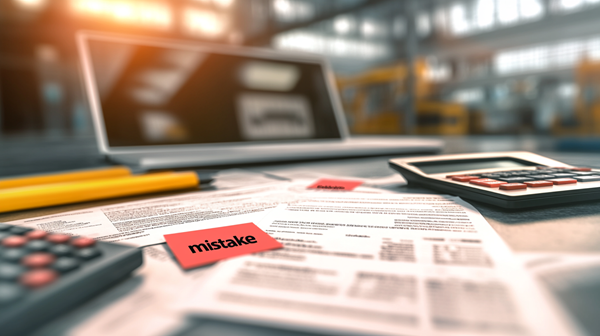Avoid common equipment financing mistakes in Australia. Learn how to choose the right lender, understand balloon payments, and maximise tax breaks.
Key Takeaways
- Ignoring Balloon Payments: Many businesses overlook balloon payments in equipment financing agreements, leading to unexpected costs down the road. Be aware that balloon payments can significantly increase the total amount you’ll pay by the end of your contract.
- Choosing the Wrong Lender: Picking a lender based on convenience rather than a fit for your financial needs can cost your business. Compare interest rates, loan terms, and customer service to find the best deal.
- Forgetting Tax Breaks: Not considering the tax advantages available through financing can mean losing out on significant savings. Research the Australian tax benefits of equipment financing, such as instant asset write-offs and depreciation allowances.
- Overlooking Equipment Fit for Your Needs: Selecting equipment based on brand or price alone can lead to poor performance and additional costs. Understand the total cost of ownership (TCO) to make smarter, longer-term decisions.
- Not Understanding the Fine Print: Always read the terms and conditions. Hidden fees and high early termination costs can quickly make an affordable-seeming deal expensive.
Understanding Equipment Financing in Australia
Equipment financing is a powerful tool for businesses across Australia, helping you spread the cost of essential machinery and technology over time. Whether you’re buying new or used equipment, the right financing plan can improve cash flow, allow for business expansion, and even unlock valuable tax benefits. However, navigating the complex world of equipment financing can be tricky.
Many businesses make common mistakes that can end up costing them far more than they bargained for. This article will guide you through the five most common mistakes made when financing equipment in Australia and offer tips on how to avoid them. We'll also cover the latest trends in the Australian market, real statistics, and provide you with actionable advice to make the most of your equipment financing.
Mistake #1: Ignoring Balloon Payments
What is a Balloon Payment?
A balloon payment is a substantial lump sum due at the end of a financing term, typically ranging from 20% to 40% of the loan amount. IWhile this structure can reduce monthly repayments, it results in a significant final payment.?
Many businesses in Australia opt for financing that includes balloon payments without fully understanding their long-term impact. According to recent research, around 35% of Australian small businesses admit to not fully understanding the details of their equipment financing agreements, including balloon payments. This can lead to a situation where businesses are left scrambling for cash or end up refinancing the balloon payment at unfavourable terms.
Why This is a Problem
- Financial Strain: Without planning, the balloon payment can disrupt cash flow, especially if your business's financial situation doesn't align with this large expense.?
- Increased Total Cost: While monthly payments may be lower, the accumulated interest over the loan term can make the equipment more expensive in the long run.
How to Avoid This Mistake
- Assess Affordability: Evaluate your business's financial capacity to handle a balloon payment without compromising operations.?
- Consider Alternatives: Explore financing options without balloon payments to maintain predictable cash flow.?
- Negotiate Terms: Discuss flexible payment structures with lenders that align with your financial strategy.
Mistake #2: Choosing the Wrong Lender
What Happens When You Choose the Wrong Lender?
Many businesses rush to secure financing from the first lender they come across, whether it's a bank, a finance company, or a specialised lender. However, this approach can be a costly mistake if you don’t shop around and compare rates.
The Numbers Speak for Themselves
In a 2024 survey by the Australian Small Business and Family Enterprise Ombudsman, 42% of small businesses reported that they didn't compare financing offers before agreeing to terms. This can result in paying higher interest rates and fees than necessary.
Why This is a Problem
- Interest Rates: A small difference in interest rates can have a huge impact. For example, a 1% increase in your rate could add thousands to the cost over the life of the loan.
- Customer Service: Poor customer service from your lender could lead to delays or misunderstandings, which can impact your business operations.
How to Avoid This Mistake
- Compare Offers: Obtain quotes from multiple lenders to identify the most competitive rates and terms.
- Evaluate Lender Reputation: Research customer reviews and ratings to gauge reliability and service quality.?
- Consult Experts: Engage with financial advisors or brokers who can guide you to suitable lending options.
Mistake #3: Forgetting Tax Breaks
Tax Breaks Available for Equipment Financing
In Australia, equipment financing can be a tax-effective way to invest in machinery. The government offers several tax incentives to businesses that finance equipment purchases, including:
- Instant Asset Write-Off: For businesses with an annual turnover of less than $50 million, you can immediately deduct the full purchase price of qualifying assets (up to $30,000) in the year you buy them. This is available for assets purchased until June 2025 under the current stimulus measures.
- Depreciation: If your purchase exceeds the instant asset write-off threshold, you may still claim depreciation on the equipment over its useful life, reducing your taxable income.
Why This is a Problem
- Missed Savings: Not utilising this deduction means higher taxable income and increased tax liability.?
- Complex Eligibility: Misunderstanding eligibility criteria can lead to non-compliance and potential audits.
How to Avoid This Mistake
- Consult Tax Professionals: Engage with accountants to ensure your financing strategies align with current tax laws.?
- Stay Informed: Regularly review updates from the Australian Taxation Office (ATO) regarding asset write-offs and depreciation rules.?
- Document Assets Properly: Maintain accurate records of asset purchases and their business usage to support your claims.
Mistake #4: Overlooking Equipment Fit for Your Needs
Choosing Equipment Based on Price, Not Fit
It’s tempting to go for the cheapest option, but choosing equipment that doesn’t suit your needs can cost more in the long run. From maintenance to inefficiency, the wrong equipment can lead to higher operational costs.
The Numbers Behind Equipment Selection
According to the Australian Bureau of Statistics, 48% of businesses reported equipment-related inefficiencies, many of which were linked to choosing equipment that didn’t align with the business's specific needs.
Why This is a Problem
- Operational Inefficiencies: Equipment that doesn't align with your needs can hinder productivity.?
- Increased Costs: Misaligned equipment may lead to higher maintenance and operational expenses.
How to Avoid This Mistake
- Assess Operational Requirements: Identify the specific needs of your business to select appropriate equipment.?
- Consider Total Cost of Ownership: Evaluate not just the purchase price but also maintenance, energy consumption, and other operational costs.
Mistake #5: Not Understanding the Fine Print
The Hidden Costs in Financing Contracts
The fine print in financing contracts can hide various fees that add up over time, such as:
- Early Termination Fees: Some contracts have hefty fees if you want to pay off the loan early or return the equipment before the term ends.
- Fees for Late Payments: These can increase your total debt and affect your credit score.
- Insurance Requirements: Lenders may require you to have insurance on the equipment, which adds to the cost.
Why This is a Problem
- Unforeseen Costs: Lenders may charge extra fees for early repayment, late payments, or administrative costs that can quickly add up.
- Complex Terms: Terms like variable interest rates, fees for early loan termination, and additional charges for default can impact your overall costs.
How to Avoid This Mistake
- Read Every Clause: Ensure that all terms, including interest rates, fees, and penalties, are clearly understood. Don’t hesitate to ask questions if anything is unclear.
- Seek Clarification on Fees: Identify any hidden or non-obvious charges. Knowing all associated costs upfront will help you avoid surprises later.
- Consider Legal Advice: Engage a lawyer or financial advisor to thoroughly assess the agreement and ensure that the terms are in your favour.
FAQs
- What are the best types of equipment financing for Australian businesses?
The best option depends on your business’s financial position and needs. Common types of equipment financing in Australia include lease financing, hire purchase agreements, and chattel mortgages. Each has different tax and cash flow advantages. - Can I get an instant asset write-off for second-hand equipment?
Yes, as long as the equipment meets the necessary criteria and the total cost is under $30,000, you can claim the instant asset write-off for second-hand equipment. - What should I do if I can't afford the balloon payment?
If you're worried about the balloon payment, talk to your lender early to explore refinancing options or renegotiating the terms. It’s better to address the issue before the payment comes due. - How can I avoid the risks of balloon payments?
Opt for financing options with fixed monthly payments and no balloon payments if you prefer predictable cash flow. Always assess your ability to pay off the balloon when negotiating terms. - How can I find the best interest rate for my equipment finance loan?
Compare offers from various lenders, including banks, credit unions, and online lenders. Be sure to consider both the interest rate and any associated fees. Additionally, assess the total cost of the loan, including any balloon payments, early repayment penalties, or hidden charges. Using a finance broker can also help you find the best rate suited to your business's needs.
Conclusion
Avoiding these five common mistakes when financing equipment in Australia is crucial to making smarter, more cost-effective decisions for your business. By being aware of the risks of balloon payments, choosing the right lender, taking full advantage of tax benefits, selecting the right equipment, and understanding the fine print, you can ensure that your equipment financing works for your business — not against it.
Take the time to compare options, consult with experts, and make informed decisions that will save you money and time in the long run.


